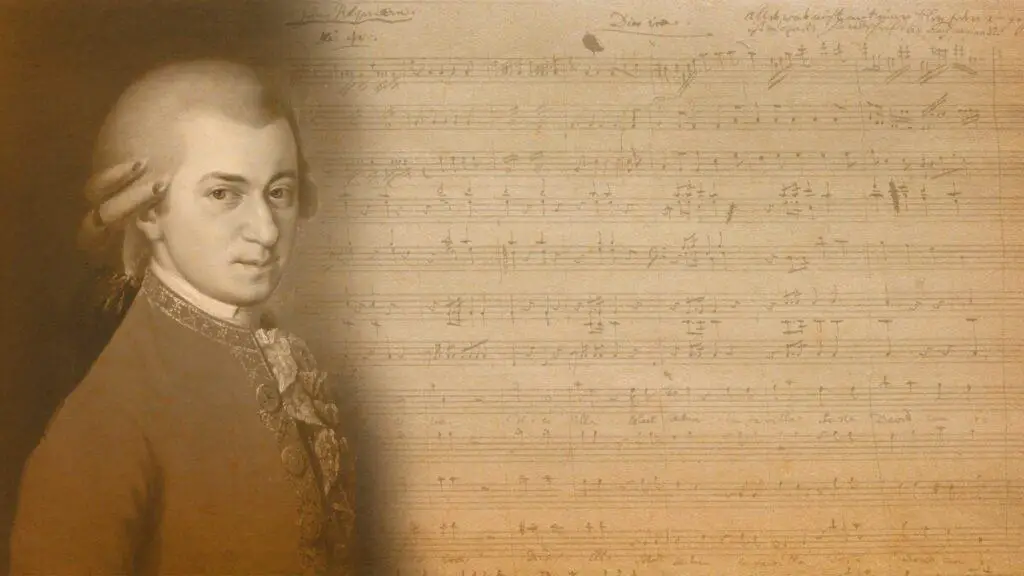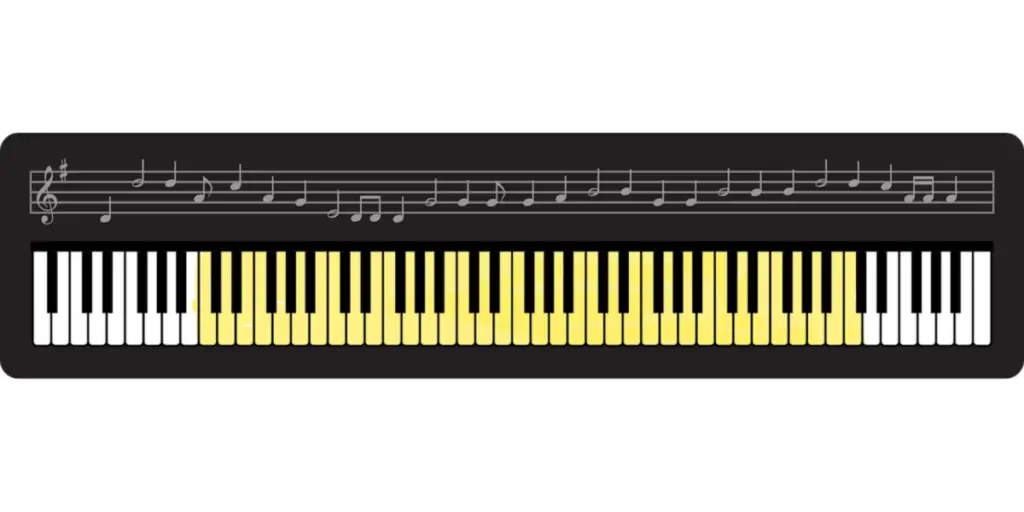This post contains affiliate links.

Mozart is world-famous, and the name is known even to people that don’t listen to classical music. His pieces are popular choices for piano players to play on the piano. However, for those that can only afford 61-keys keyboards, which Mozart’s pieces can be played on 61 keys?
Here are 3 Mozart pieces to play on a 61-keys keyboard:
- Piano Sonata in C Major, No. 16, K545 (1st Movement)
- Minuet in G, K. 1
- Rondo Alla Turca (Turkish March)
In this article, I’ll go into more detail about why Mozart can be played on 61 keys and how to play Mozart pieces that don’t fit on 61 keys.
Finally, I’ll list out 3 Mozart pieces and detail about those pieces so you choose one to play on your keyboard.
The reason Mozart can be played on 61 keys
Mozart can be played on 61 keys because, during his time, there are only 5 octaves (61 keys) on the keyboard instruments of that era. Thus, most of Mozart’s piano pieces are composed using 61 keys. Nowadays, Mozart’s pieces are transcribed to be played on the modern piano keyboard.
Mozart was able to play many different instruments throughout his life, with his favourite being the viola. In terms of keyboard instruments, he played the harpsichord and clavichord, the keyboard instruments of the Baroque era he lived in.
The clavichord produces sound by having metal blades called tangents striking the strings while the harpsichord produces sound by plucking the strings.
Mozart also played the fortepiano – the first edition and direct predecessor of the modern piano with 88 keys we know today. All of these keyboard instruments have 5 octaves, although not the same 5 octaves starting from C to C like on an electric 61-keys keyboard.
Highest and lowest notes of a Mozart piece for a 61-keys keyboard
A 61-keys keyboard starts from C and ends on a C and has 5 octaves. Here are those 5 octaves on a normal piano with 88 keys:

Here’s what the range looks like on a grand staff on music sheets:

This means if you want to play full-length pieces from Mozart on a 61-keys keyboard, those pieces have to fit into this C to C range.
However, that doesn’t mean you can’t play Mozart pieces that don’t fit within the 61-keys range. There are several different compromises you can make so that you can play any Mozart piece even with the keyboard limitation.
Ways to play Mozart pieces that don’t fit within 61 keys
Omit parts from the piece
If a bolt doesn’t fit into a frame, the simplest solution is to forget about that bolt instead of trying a bolt that fits. However, this would make the frame wobbly.
This also applies to Mozart pieces: if a section doesn’t fit on 61-keys, omit that section so you can play the rest on the keyboard. However, that makes the piece sounds incomplete.
With that said, in some cases, even after excluding the parts that don’t fit on 61 keys, the modified version will still sound similar to the original. This is to the point where unless you’re actively paying attention, you won’t even notice that there’s a part missing from the piece.
This is perfect if you’re only playing for yourself or your friends and families that don’t play the piano and so won’t notice the gap in the piece.
An example of a piece that still sounds the same after omitting some parts is Fur Elise by Beethoven. In Fur Elise, there are only a few notes at the end that is just outside the 61 keys range, and so even after excluding those notes, the piece still sounds the same.
I talk about the notes to exclude from Fur Elise and how it sounds like compared to the original in this article: Can Fur Elise be Played on a 61 Keys Keyboard?
On the other hand, If you don’t want to omit anything from the Mozart piece since it bugs you and wants to play the whole thing from start to finish on 61 keys, you can consider transposing your keyboard to shift one octave up so that the piece can fit in.
Transpose to shift the keyboard one octave up
Every electric piano keyboard nowadays has a “transpose” function. It can be a physical button, a knob or a sequence of keys pressed to activate it.
Imagine a full range of 88-keys. Nestled within it is your 61 keys keyboard. Transposing your keyboard will shift that 61-keys range either up or down to the 88-keys range. This gives you access to higher or lower keys that aren’t present in a standard 61-keys keyboard.
When you use the transpose button or knob, you either go up or down one semitone (half-step) at a time. A half-step is the distance between a white key and the black key right next to it, or from a white key to the next white key for A-B and E-F. A whole tone equals two semitones (or 2 half-steps).
However, in practice, we transpose keyboards either one octave up or down, so all 61 keys still correspond to the same correct notes, just that the notes have a higher or lower pitch because of the octave shift.
Here’s an example of what the transpose button looks like on a particular piano keyboard model:
Transposing a keyboard is easy but is it even possible to transpose the keyboard mid-performance so that you have access to higher notes? The answer is that for harder and more complicated Mozart pieces, it’s impossible to do because you’ll have no time to hit the transpose button.
Transposing is only doable if there’s a momentary rest in the piece where you can quickly transpose. Or if there’s a way to preset the transpose button to shift an octave up beforehand.
If there’s isn’t a physical button or there’s a sequence of steps to shift octaves, it’ll impossible to transpose while you’re playing and thus, omitting notes is the better option if you want to play Mozart pieces on 61 keys.
Personally, I prefer to omit notes rather than transposing the keyboard since the omitted version doesn’t sound much different than the original, and I don’t have to waste time figuring out how to use the transpose function on the keyboard.
Finally, the transpose button isn’t universal and is different for different keyboards. Check out your keyboard’s user manual to learn how to activate the transpose function if there isn’t a physical button on the keyboard and how to use it. You can search for an online PDF of the manual if you lost the physical copy of it.
Find modified versions of the Mozart pieces
The third method is to find a modified version of the Mozart piece you want to play, arranged specifically for a 61-keys keyboard. Out there on the Internet, there are people that create modified versions of a piano piece for different reasons: to make it easier, make it jazzier, or in our case, so that it fits on 61 keys.
This option is the best since this modified version is written for 61 keys, and won’t sound incomplete compared to omitting some parts from the piece.
The downside is that for less popular Mozart pieces, there may not be versions that are written to fit on 61 keys.
Mozart pieces to play on a 61-keys keyboard
Piano Sonata in C Major, No. 16, K545 (1st Movement)
This is Mozart’s most well-known sonata, with a pleasant and catchy melody that will get stuck in your head for the next week. The sonata was published after his death and was described by Mozart to be “for beginners”.
The first movement has a lot of scale-like passages so remember to practice your scales so you’ll have an easier time learning those passages.
You’ll also get to learn and practice trills – where you repeat 2 notes that are a semitone apart quickly and rapidly. An example of a trill is at the 0:10 mark of the video. There are many trills scattered throughout the movement.
Minuet in G, K. 1
This is Mozart’s first piece, written when he was 5 years old, solidifying his status as a child prodigy. Listening to the piece, you will definitely notice how simple it is compared to Mozart’s later works. It’s as if you can imagine little Mozart sitting on the piano playing around with the notes to compose this piece.
This piece is the perfect choice for anyone new to the piano since they will learn all the basics like notes with different values, how to keep the right rhythm and playing with both hands.
Rondo Alla Turca (Turkish March)
The third movement of Mozart’s Sonata No. 11, K. 331, Rondo Alla Turca or the Turkish March is one of Mozart’s most famous works, recognized by everyone around the world. His inspiration came from Turkish Janissary bands that were popular around that time.
Further reading
If you’re looking for more piano pieces from different composers like Beethoven or Bach to play on a 61-keys keyboard, check out 10 Classical Piano Pieces to Play on a 61-Keys Keyboard

